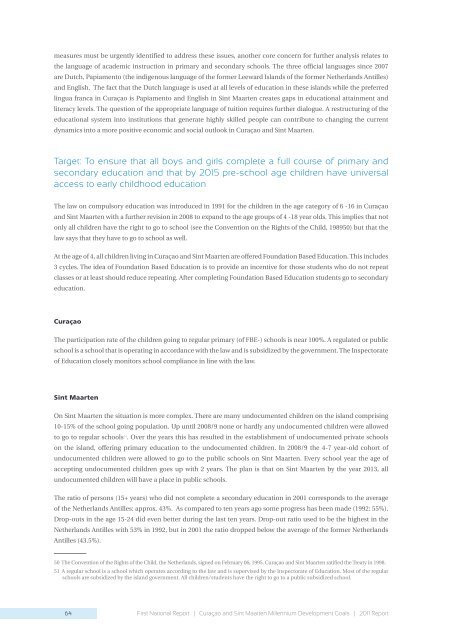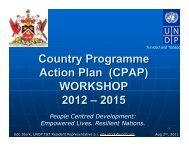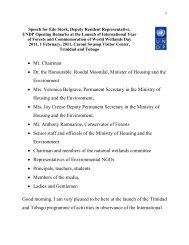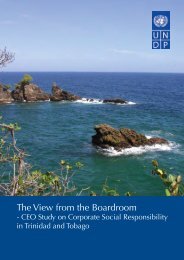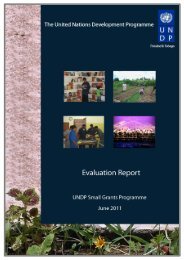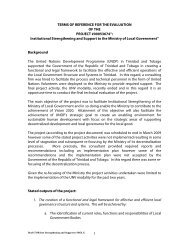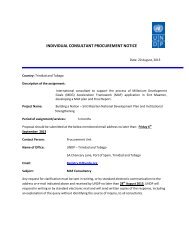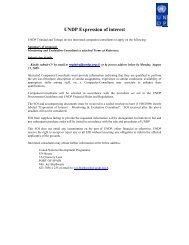Curaçao & Sint Maarten - UNDP Trinidad and Tobago
Curaçao & Sint Maarten - UNDP Trinidad and Tobago
Curaçao & Sint Maarten - UNDP Trinidad and Tobago
Create successful ePaper yourself
Turn your PDF publications into a flip-book with our unique Google optimized e-Paper software.
measures must be urgently identified to address these issues, another core concern for further analysis relates to<br />
the language of academic instruction in primary <strong>and</strong> secondary schools. The three official languages since 2007<br />
are Dutch, Papiamento (the indigenous language of the former Leeward Isl<strong>and</strong>s of the former Netherl<strong>and</strong>s Antilles)<br />
<strong>and</strong> English. The fact that the Dutch language is used at all levels of education in these isl<strong>and</strong>s while the preferred<br />
lingua franca in <strong>Curaçao</strong> is Papiamento <strong>and</strong> English in <strong>Sint</strong> <strong>Maarten</strong> creates gaps in educational attainment <strong>and</strong><br />
literacy levels. The question of the appropriate language of tuition requires further dialogue. A restructuring of the<br />
educational system into institutions that generate highly skilled people can contribute to changing the current<br />
dynamics into a more positive economic <strong>and</strong> social outlook in <strong>Curaçao</strong> <strong>and</strong> <strong>Sint</strong> <strong>Maarten</strong>.<br />
Target: To ensure that all boys <strong>and</strong> girls complete a full course of primary <strong>and</strong><br />
secondary education <strong>and</strong> that by 2015 pre-school age children have universal<br />
access to early childhood education<br />
The law on compulsory education was introduced in 1991 for the children in the age category of 6 -16 in <strong>Curaçao</strong><br />
<strong>and</strong> <strong>Sint</strong> <strong>Maarten</strong> with a further revision in 2008 to exp<strong>and</strong> to the age groups of 4 -18 year olds. This implies that not<br />
only all children have the right to go to school (see the Convention on the Rights of the Child, 198950) but that the<br />
law says that they have to go to school as well.<br />
At the age of 4, all children living in <strong>Curaçao</strong> <strong>and</strong> <strong>Sint</strong> <strong>Maarten</strong> are offered Foundation Based Education. This includes<br />
3 cycles. The idea of Foundation Based Education is to provide an incentive for those students who do not repeat<br />
classes or at least should reduce repeating. After completing Foundation Based Education students go to secondary<br />
education.<br />
<strong>Curaçao</strong><br />
The participation rate of the children going to regular primary (of FBE-) schools is near 100%. A regulated or public<br />
school is a school that is operating in accordance with the law <strong>and</strong> is subsidized by the government. The Inspectorate<br />
of Education closely monitors school compliance in line with the law.<br />
<strong>Sint</strong> <strong>Maarten</strong><br />
On <strong>Sint</strong> <strong>Maarten</strong> the situation is more complex. There are many undocumented children on the isl<strong>and</strong> comprising<br />
10-15% of the school going population. Up until 2008/9 none or hardly any undocumented children were allowed<br />
to go to regular schools51 . Over the years this has resulted in the establishment of undocumented private schools<br />
on the isl<strong>and</strong>, offering primary education to the undocumented children. In 2008/9 the 4-7 year-old cohort of<br />
undocumented children were allowed to go to the public schools on <strong>Sint</strong> <strong>Maarten</strong>. Every school year the age of<br />
accepting undocumented children goes up with 2 years. The plan is that on <strong>Sint</strong> <strong>Maarten</strong> by the year 2013, all<br />
undocumented children will have a place in public schools.<br />
The ratio of persons (15+ years) who did not complete a secondary education in 2001 corresponds to the average<br />
of the Netherl<strong>and</strong>s Antilles: approx. 43%. As compared to ten years ago some progress has been made (1992: 55%).<br />
Drop-outs in the age 15-24 did even better during the last ten years. Drop-out ratio used to be the highest in the<br />
Netherl<strong>and</strong>s Antilles with 53% in 1992, but in 2001 the ratio dropped below the average of the former Netherl<strong>and</strong>s<br />
Antilles (43.5%).<br />
50 The Convention of the Rights of the Child, the Netherl<strong>and</strong>s, signed on February 06, 1995. <strong>Curaçao</strong> <strong>and</strong> <strong>Sint</strong> <strong>Maarten</strong> ratified the Treaty in 1998.<br />
51 A regular school is a school which operates according to the law <strong>and</strong> is supervised by the Inspectorate of Education. Most of the regular<br />
schools are subsidized by the isl<strong>and</strong> government. All children/students have the right to go to a public subsidized school.<br />
64 First National Report | <strong>Curaçao</strong> <strong>and</strong> <strong>Sint</strong> <strong>Maarten</strong> Millennium Development Goals | 2011 Report


